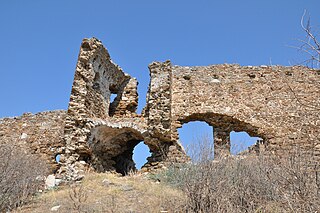Thebes or Thebae may refer to one of the following places:

Ionia was an ancient region encompassing the central part of the western coast of Anatolia. It consisted of the northernmost territories of the Ionian League of Greek settlements. Never a unified state, it was named after the Ionians who had settled in the region before the archaic period.

Caria was a region of western Anatolia extending along the coast from mid-Ionia (Mycale) south to Lycia and east to Phrygia. The Carians were described by Herodotus as being Anatolian mainlanders and they called themselves Caria because of the name of their king. He reports the Carians themselves maintained that they were Anatolian mainlanders intensely engaged in seafaring and were akin to the Mysians and the Lydians. The Carians spoke Carian, a native Anatolian language closely related to Luwian. Also closely associated with the Carians were the Leleges, which could be an earlier name for Carians.
Tripoli or Tripolis may refer to:
Heraclea, Heracleia, Herakleia, or Heraclia may refer to:
In Greek mythology, Larissa or Larisa was the name of two different figures that appears in various accounts:
Neapoli or Neapolis may refer to:
Hadrianopolis or Adrianopolis may refer to several cities named after Hadrian:
Larissa is the capital and largest city of Thessaly, Greece

The Ionian League, also called the Panionic League, was a confederation formed at the end of the Meliac War in the mid-7th century BC comprising twelve Ionian Greek city-states, and eventually thirteen city-states with the admission of Smyrna. The earliest union of city-states in the area was the Ionian League. The League survived through the Hellenistic and Roman periods, until the 3rd century AD.
Panormos or Panormus, meaning "sheltered harbor", may refer to:

Myus, sometimes Myous or Myos, or Myes, was an ancient Greek city in Caria. It was one of thirteen major settlements of the Ionian League, and was one of three that spoke the same Ionic subdialect, the other two being Miletus and Priene. All three were Ionian colonies placed at the mouth of the Maeander River in the middle of the west coast of Anatolia.
The following is a list of regions of Ancient Anatolia, also known as "Asia Minor." The names reflect changes to languages, settlements and polities from the Bronze Age to conquest by Turkic peoples.
Larissa, was an ancient Greek city in the south-west of the Troad region of Anatolia. Its surrounding territory was known in Greek as the Λαρισσαῖα (Larissaia). It has been located on a small rise by the coast now known as Limantepe, about 3.5 km from the village of Kösedere to the north-east and 3 km from the village of Babadere to the east, in the Ayvacık district of Çanakkale province, Turkey. As with other Greek toponyms containing the consonantal string -ss-, spellings that drop one 's' exist alongside those that retain both in the ancient literary sources. Larisa in the Troad should not be confused with 'Aeolian' Larissa, near Menemen, or with 'Ionian' Larissa in İzmir province.

The prehistory of Anatolia stretches from the Paleolithic era through to the appearance of classical civilization in the middle of the 1st millennium BC. It is generally regarded as being divided into three ages reflecting the dominant materials used for the making of domestic implements and weapons: Stone Age, Bronze Age and Iron Age. The term Copper Age (Chalcolithic) is used to denote the period straddling the stone and Bronze Ages.
Polichna is a village in Poland.
Dascylium was a city in ancient Mysia or Bithynia, capital of Hellespontine Phrygia.
This page is based on this
Wikipedia article Text is available under the
CC BY-SA 4.0 license; additional terms may apply.
Images, videos and audio are available under their respective licenses.




